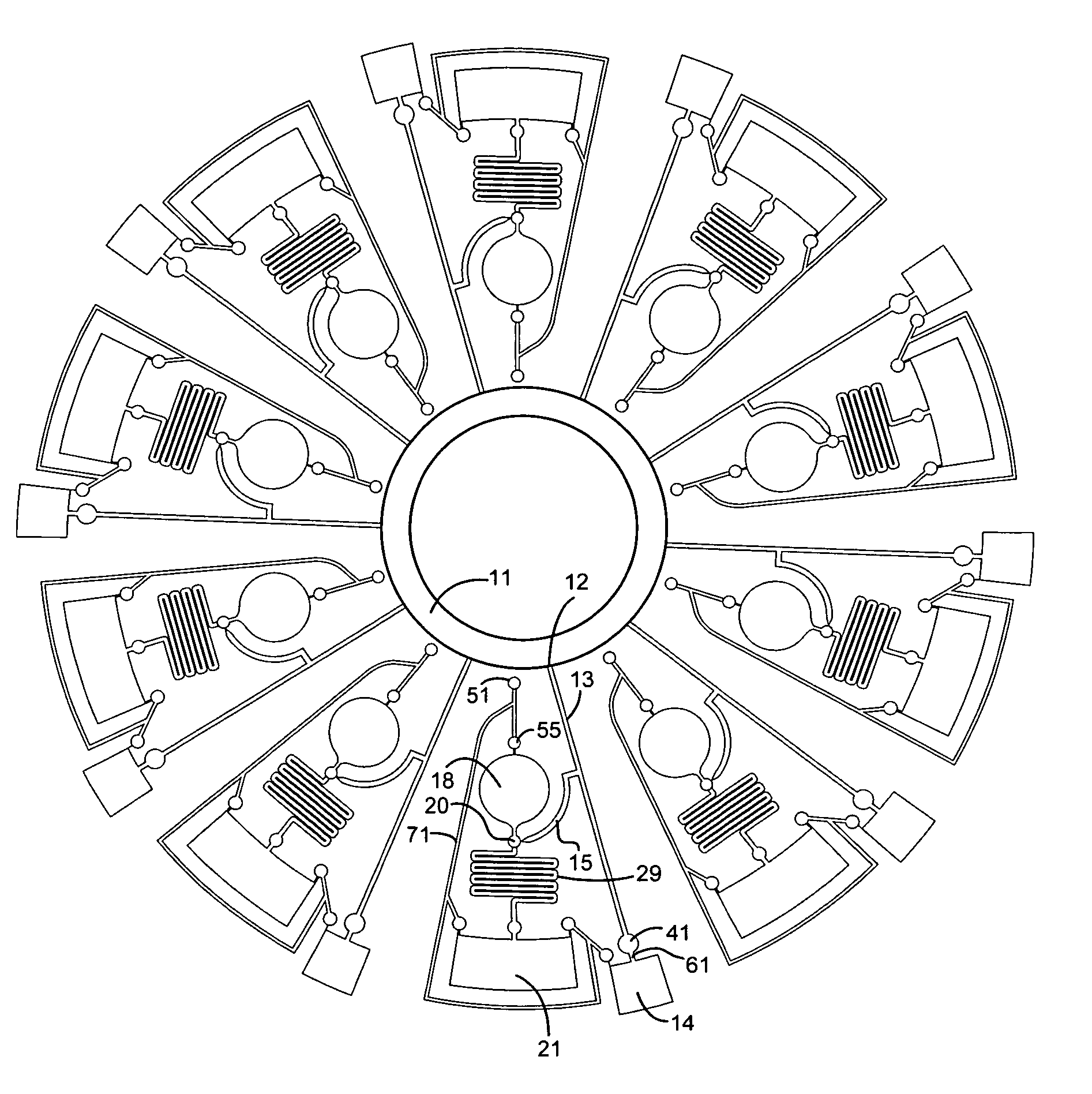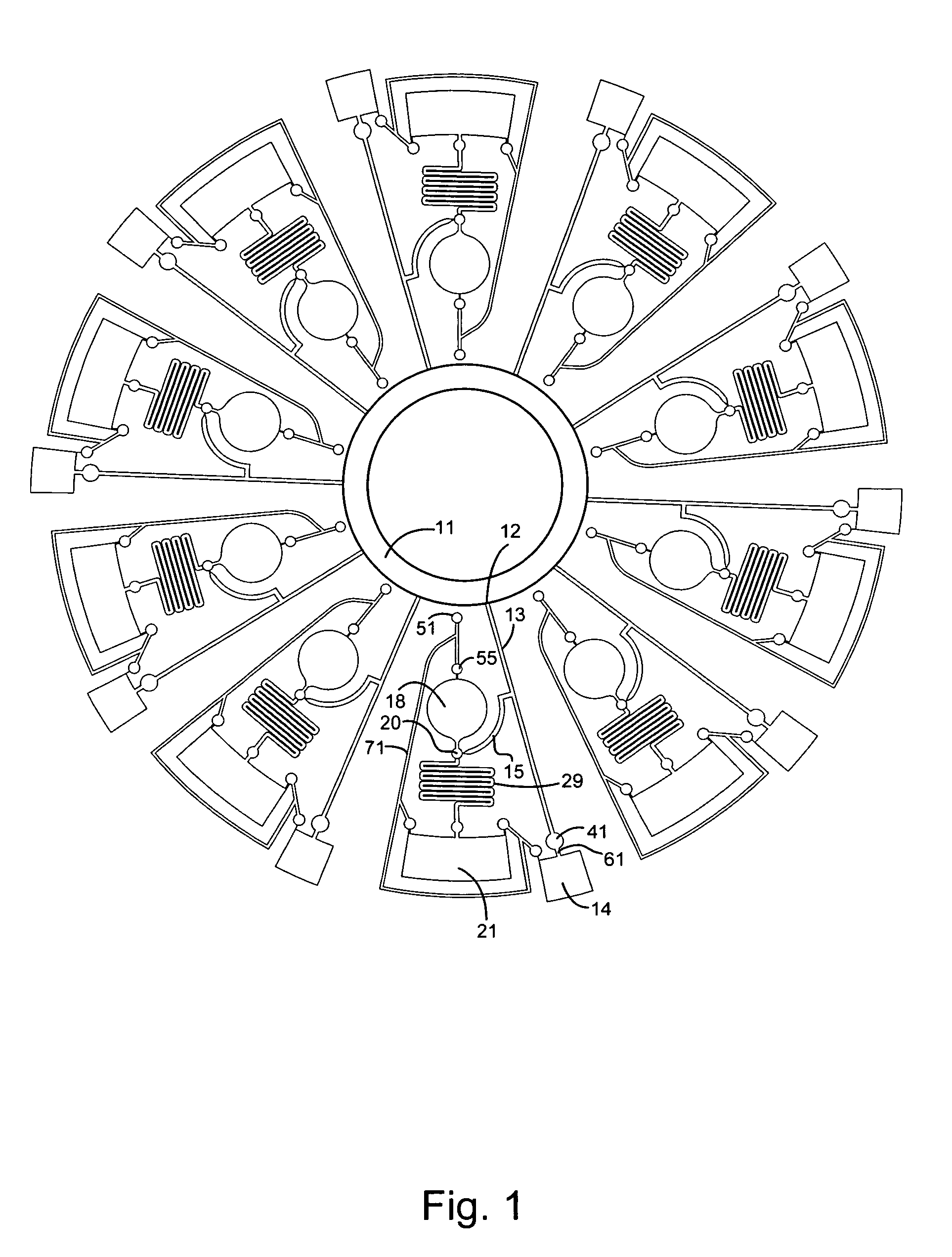Centrifugal fluid analyzer rotor
a centrifugal fluid and analyzer technology, applied in the field of centrifugal fluid analysis rotors, can solve the problems of frequent use of complex designs which are costly and difficult to manufacture, labor intensive and time-consuming, and the limitations of previous centrifugal rotors
- Summary
- Abstract
- Description
- Claims
- Application Information
AI Technical Summary
Benefits of technology
Problems solved by technology
Method used
Image
Examples
example 1
General Metering by Contact of Fluids
[0096]To illustrate the principles of liquid metering according to one preferred embodiment of present invention, we now refer to FIGS. 3A-F. In FIG. 3A, it shows a schematic of a microfluidic tube 2 which has a body section 3 and tip section 4. The tip section 4 has a relatively smaller diameter than the body section 3. The typical dimensions of the diameters of body section 3 and tip section 4 range from several microns to several hundred microns. The length of the tube 2 is on the order of several hundred micrometers to a few centimeters.
[0097]Referring to FIG. 3B, a first fluid 5 is added into the said microfluidic tube 2. This first fluid 5 can be, e.g., a biological fluid, an ordinary soft drink, a chemical or even drinking water. Under the capillary force, the first fluid 5 will maintain a certain amount of volume in the microfluidic tube 2 as illustrated in this schematic. At the same time, the first fluid 5 will also form a meniscus 6 at...
example 2
Multi-Assay Rotors with a Sample Metering Tubes
[0101]A centrifugal fluid analyzer rotor incorporating a fluid contact triggered metering tube according to one preferred embodiment of present invention is shown in FIG. 1. The rotor has a plurality of assaying units, each connected to a common sample chamber 11 through sample inlet opening 12 and sample channel 13. The sample channel 13 is connected to a liquid metering tube 15, and also waste chamber 14 through bubble 41 and a narrow section 61. Narrow section 61 and the bubble 41 form a capillary stop valve such that the sample biological fluid stored in the waste chamber 14 can not flow (e.g., by capillary action) back into the sample channel 13.
[0102]A more detailed view of one assaying unit of the centrifugal fluid analyzer rotor is shown in FIG. 2. In addition to what is described earlier, this assaying unit includes reagent chamber 18, a mixing chamber 20 and a detection chamber 21. The reagent chamber 18 is connected to the mi...
example 3
Precise Metering of a Sample Fluid into a Reagent
[0106]To understand more about the working principles of the centrifugal fluid analyzing rotor according to one preferred embodiment of present invention, we refer to FIGS. 4A-H. These figures schematics that are used to illustrate the principles, but are not intended to limit the scope of the inventions. In FIG. 4A, sample chamber 11, reagent chamber 18, liquid metering tube 15, waste chamber 14, and detection chamber 21 are all fluidly connected through a network of micro channels, e.g., similar to those shown in FIGS. 1 and 2. In reagent chamber 18, reagent 22 is pre-packaged in a known desired volume, as shown in FIG. 1. To simplify the drawings, the mixing maze 29 and bubble 42 are not drawn in the figure. In this figure, the (vertical) axis of rotation 1 is shown such that the rotation of the assay analyzing unit is in the plane as shown. In this case, FIGS. 4A to 4H show the plan view of an assay analyzing unit. The sample cham...
PUM
| Property | Measurement | Unit |
|---|---|---|
| Angular velocity | aaaaa | aaaaa |
| Angular velocity | aaaaa | aaaaa |
| Speed | aaaaa | aaaaa |
Abstract
Description
Claims
Application Information
 Login to View More
Login to View More - R&D
- Intellectual Property
- Life Sciences
- Materials
- Tech Scout
- Unparalleled Data Quality
- Higher Quality Content
- 60% Fewer Hallucinations
Browse by: Latest US Patents, China's latest patents, Technical Efficacy Thesaurus, Application Domain, Technology Topic, Popular Technical Reports.
© 2025 PatSnap. All rights reserved.Legal|Privacy policy|Modern Slavery Act Transparency Statement|Sitemap|About US| Contact US: help@patsnap.com



